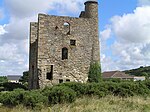Brea, Cornwall
Cornwall geography stubsVillages in Cornwall

Brea (Cornish: Bre) is a village in Cornwall, England, UK, between the towns of Camborne and Redruth. It is in the civil parish of Carn Brea and consists of Brea, Lower Brea, and Higher Brea. A small stream, the Red River, flows through the village and a hill, Carn Brea dominates the landscape to the east, along with its monument to Francis Basset.
Excerpt from the Wikipedia article Brea, Cornwall (License: CC BY-SA 3.0, Authors, Images).Brea, Cornwall
Geographical coordinates (GPS) Address Nearby Places Show on map
Geographical coordinates (GPS)
| Latitude | Longitude |
|---|---|
| N 50.2109 ° | E -5.2715 ° |
Address
TR14 9AU
England, United Kingdom
Open on Google Maps







